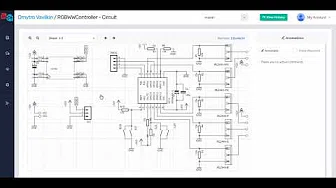Files
Scanning the repository...
| FileslibraryKiCad-RP-Pico-main | |
|---|---|
| .. | |
| Images | |
| RP-Pico Libraries | |
| SketchUp Model | |
| Test | |
| .gitignore | |
| Install instructions.md | |
| LICENSE | |
| README.md |
Install instructions.mdInstall instructions
1. Copy the files locally
Copy the
RP-Pico Librariesfolder wherever you like on your computer.2. Install the Raspberry Pi Pico board schema symbol
Use the
KiCad | Preferences | Manage Symbol Libraries...command to manage the symbol library:
then select the global tab and click on the folder button:
navigate to the
RP-Pico Librariesfolder, select theMCU_RaspberryPi_and_Boards.kicad_symfile and open it:
et voilà, the first step is completed:
You can now close the symbol libraries manager window.
3. Install the Raspberry Pi Pico board footprint
You can use a similar approach to add the footprint to the footprint libraries manager, but I've found some issues that I've solved using the footprint editor, so here are the steps I suggest you to follow:
Open the footprint editor
wait for the footprints to load... then use the
File | Add Librarycommand:
confirm the
Globalchoice:
and select the
MCU_RaspberriPi_and_Boards.prettyfolder (yes, the folder represent a footprint library on KiCad):
Now the library is installed on KiCad with the Raspberry Pi Pico footprint (double click on it to see it on the editor pane):
Don't close the windows as the next step start from here.
4. Install the Raspberry Pi Pico board footprint 3D visual
If not already open, open the the footprint editor
double click on the
RPi_Pico_SMD_THfootprint from theMCU_RaspberriPi_and_Boardslibrary and then click on theFootprint propertiesicon:
In the footprint properties window, first select the
3D Settingstab. Please note that the preview shows only the PCB board with the footprint added on step 3, without any 3D representation of the Raspberry Pi Pico board. Now click on the folder icon to add the 3D model:
Navigate to the
RP-Pico Librariesfolder, select thePico.wrlfile and wait until the model is shown in the right panel, then confirm with OK:
The model is already scaled and translated to match the footprint:
now close the
Footprint Propertieswindow, and theFootprint Editor, obviously saving the changes.Conclusion
Now that you've installed the schema and footprint and added the 3D model to the footprint, you can use the Raspberry Pi Pico board on your KiCad projects.
I've also added a test KiCad Project on the
Testfolder, that you can use to see an example of it.Have fun!








